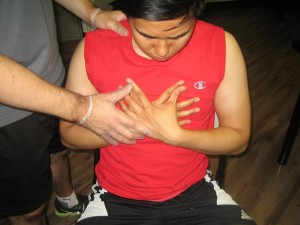The chest cavity houses the lungs which are the primary organs that filter out air and supply oxygen to the blood. The inflammation that develops in the chest cavity is due to swollen lungs or the bronchial tubes. Take note that this condition is linked to bronchitis, pneumonia and allergic reactions. The chest cavity inflammation is considered manageable but in rare circumstances, the inflammation can be life-threatening for the elderly and for young children. The chest pain might indicate another condition that requires proper assessment by a doctor.
Allergies
Always bear in mind that not all allergies can cause chest inflammation. Individuals who suffer from allergic asthma are more likely to develop inflammation in the chest cavity. When it comes to allergic asthma, it involves swelling in the lungs due to contact to various aerial allergens. An allergen is any material in which the immune system is highly sensitive to upon exposure. An individual with allergic asthma can suffer from chest pain, shortness of breath and wheezing.
The treatment for allergic asthma involves avoidance of allergens, antihistamine and corticosteroid inhalers. In some cases, allergy shots can be used to manage allergic asthma.

Pneumonia
Pneumonia is a condition that causes infection in the lungs that triggers inflammation. This condition is usually not an issue to worry about for most healthy adults, but can become life-threatening among the elderly and young children.
Most of the symptoms of pneumonia are similar to bronchitis and requires proper assessment by a doctor. Pneumonia can cause fever, shaking, chills, chest pain, fever and muscle pain. When it comes to bacterial pneumonia, it is managed with antibiotics and starts to improve within 48 hours. As for viral pneumonia, it is treated with adequate rest and increased intake of fluid. Proper assessment is vital so that appropriate treatment options can be started. Remember that treatment is vital especially among the elderly and young children.
Bronchitis
Bronchitis is a viral or bacterial infection in the airways of the lungs called the bronchial tubes. Most cases of bronchitis start as a cold in the sinuses that spreads into the lungs. The infection causes inflammation in the bronchial tubes that result to swelling and over-production of mucus.
The symptoms of bronchitis include difficulty breathing, wheezing, body chills, fever, chest discomfort and coughing. The doctor can correctly identify bronchitis. In case it is bacterial bronchitis, it is managed with the prescribed antibiotics and getting enough rest. Viral bronchitis is managed with rest and over-the-counter medications to alleviate the symptoms. In most cases, expectorants, cough suppressants and fever reducers are used to manage the symptoms.
Depending on the cause of chest cavity inflammation, it is best to schedule an appointment with a doctor for proper assessment as well as start the appropriate treatment.
